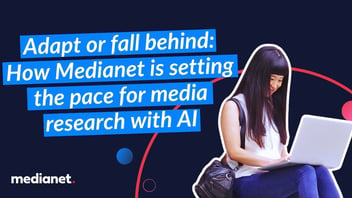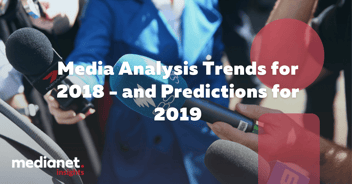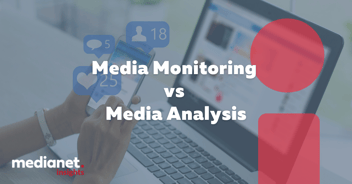Trending in 2023: AI technology and the importance of human roles in modern media analysis
.png?width=1920&height=300&name=Trending%20in%202023%20(1920%20%C3%97%20300px).png) AI is by far the talk of 2023 with discussions flooding LinkedIn and online conversation. The presence of AI technology has increased exponentially as of late. Particularly with the release of ChatGPT which has almost single-handedly put AI back in the spotlight. This influx of activity has highlighted the importance of human-centric roles to not only guide and train AI in the right direction, but also to make up for the many shortcomings you will find in their limited set of parameters.
AI is by far the talk of 2023 with discussions flooding LinkedIn and online conversation. The presence of AI technology has increased exponentially as of late. Particularly with the release of ChatGPT which has almost single-handedly put AI back in the spotlight. This influx of activity has highlighted the importance of human-centric roles to not only guide and train AI in the right direction, but also to make up for the many shortcomings you will find in their limited set of parameters.
Human insight can make all the difference when it comes to reading between the lines of media stories and understanding the nuances of complex topics. As highlighted in an article on Forbes, AI is still significantly flawed when it comes to understanding human language, particularly around understanding ‘common sense’ and advanced concepts such as sarcasm, which can return many inaccuracies that need to be fact-checked by a human. As technology advances, it is important to find ways to integrate human thinking into media analysis to make sure that we are getting the most out of the data and information we are receiving.
Let’s explore how media analysis trends are changing in 2023 making human-driven roles more critical than ever before.
Shortcomings of AI in media analysis
AI technology has made incredible advances in its role in supporting media analysis, but it still falls short in many areas. One of the main issues is that AI algorithms are based on data sets that are limited and full of assumptions. As a result, AI programs can be found to be inaccurate and lack the ability to comprehend new ideas and new ways of thinking. Due to these limitations, AI algorithms often have difficulty detecting subtle nuances in text, audio, and video, which can lead to misinterpretations or missing important details.
Take sentiment for example, a key metric used to determine how an audience feels or reacts to a brand or its message. Have a read of the example sentence below and decide how you would rate the sentiment yourself - positive, neutral or negative?
"The new traffic plan is the best thing to happen to this city since the invention of the wheel. I can't wait to spend hours sitting in gridlock every day."
Whilst we may read this and understand the overall sentiment is negative, an AI-based sentiment analysis program might struggle because it contains sarcasm which often involves saying the opposite of what one means. The statement appears to be positive with the use of words like "best" and "can't wait," but the context of the statement, specifically the phrase "spend hours sitting in gridlock every day," makes it clear that the sentiment is actually negative.

The above screenshot highlights the results from a sentiment analysis program by MonekyLearn which is further supported by Grammarly’s tone analysis (which indicates the tone of the statement to be exciting). Both examples show inaccuracies that we as humans would have little trouble understanding.
The flip side of AI: Consultative Insights
Consultative Insights. You’d be forgiven if you hadn’t heard of it before, insights by nature can be a very niche topic after all. In short, Consultative Insights is the step beyond data collection to understand the meaning and impact of media coverage in the context of a company’s goals.
Let’s use an example to explore this further.
Say you're running a media campaign to launch a new partnership. You’ve sent out a press release and Journalists have been publishing your story left, right and centre.
How would you evaluate the success of the campaign?
You could start by looking at key metrics such as the volume of coverage that you’ve generated, or reviewing any changes in traffic to your site, likely caused by the campaign.
Both of these metrics however only tell one part of the story and can be misleading without the right insights to back them up. If you start combining these metrics you get even closer to the source of truth but this is where Consultative Insights come in.
Let’s expand the scenario further and give the campaign a goal. Let’s say “bring awareness to the partnership and the brands involved.”
Looking at the volume of coverage here alone might indicate awareness of the partnership, but you won’t know for sure until you dig deeper to explore what the media is covering. Supporting metrics such as key message delivery (you can learn more about that here) can aid in understanding if the media actually picked up on the message you were pushing (in this case the announcement of a new partnership) or if they were focusing on something else (perhaps changes happening to one of the brands involved).
This is where the human element of Consultative Insights comes in. Throughout the process of analysing media coverage, an analyst looks at every media item separately and generates a complete picture of the campaign to give you the answers you need, supported by the data they themselves have analysed.
Integrating human roles with future technology
With the progression of AI, it’s clear that it is here to stay and will likely become another tool in the toolkit of communication professionals. So, how will it impact the role of humans when it comes to media analysis?
Whilst AI itself has been around for generations in one way or another, it’s still fairly new when it comes to modern technology. It’s important to not get too caught up in the current buzz and recognise its limitations. As such, this exciting technology is best placed as a supporting tool for companies and analysts alike to use. Similarly, other tech tools such as media monitoring can be an important part of the process to gather and organise media data (such as media clippings) before being passed on to an expert analyst to process and interrogate that data further.
Understanding and maintaining such a relationship between humans and AI will be an important step in progressing the industry further for years to come. After all, AI was developed to support us and make our lives simpler, not take over completely.
Are you ready to kickstart your journey in media analysis with Consultative Insights?
Get in touch with us to find out more.
🤖🤖🤖



